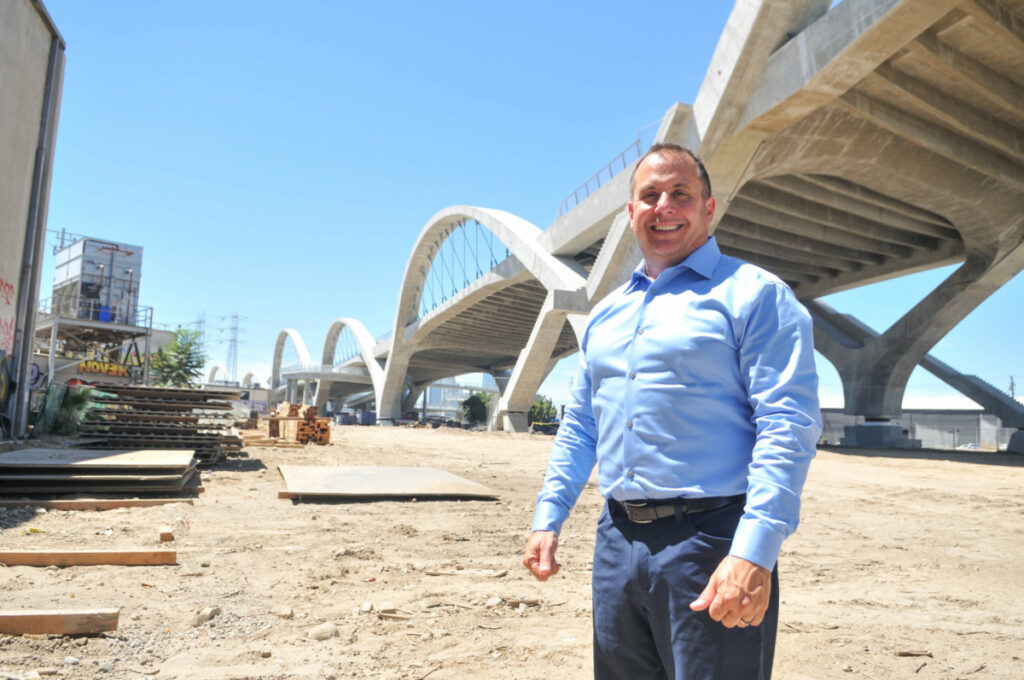For most of its 76 years, downtown Los Angeles-based engineering, planning and surveying firm Psomas has focused primarily on the California market, only gradually growing its presence in three other Western states.
In the process, the company has grown from a small boutique land-surveying firm to a middle-market engineering company providing an array of services, including construction management, engineering, master planning, environmental consulting and its original land surveying. The company, which is 100% owned by its more than 700 employees, now has 18 offices: 12 in California and six in three other Western states.
Psomas posted about $130 million in revenue last year, placing it No. 15 in the annual ranking of design firms by trade publication Engineering News Record.
But now, Chief Executive Steve Margaroni, who took the helm just two months before the pandemic hit, has an ambitious expansion plan for the company, with the aim of solidifying its presence throughout the Western U.S.
Psomas took a step in that direction in January, acquiring Seattle-based land planning and surveying firm KPG. Margaroni recently completed a trip to Seattle to help integrate KPG’s 100-plus employees into Psomas.
In a sense, Margaroni is continuing the strategy of growth by acquisition started by one of his predecessors, Tim Psomas, son of the late founder George Psomas; the younger Psomas retired in 2010. During the first two decades of this century, Psomas acquired nine firms. But Margaroni is now looking at a somewhat larger game board.
“The KPG acquisition was part of our strategic plan,” Margaroni said. “We are looking at geographic expansion outside of California to help us diversify our geographic profile. That way, when one local geographic market gets soft, we can rely on other markets to pick up the slack.”
Margaroni added the company is for now limiting the expansion to the Western U.S.
“The Pacific Northwest has been a target market for us, but we’re also looking at Idaho, Colorado and more of a presence in Utah,” he said.
Margaroni said the company would be deliberate in its future acquisitions, making sure the acquiree company is a good fit culturally with the firm.
Psomas has plenty of company in looking for acquisitions. According to Brad Diede, executive director of the California chapter of the American Council of Engineering Companies, merger and acquisition activity among engineering firms nationwide is up 21% so far this year compared to the same period last year, which itself was up from the previous year.

Softening market
At the moment, however, Margaroni has more immediate concerns. He said that some of the markets the company is in have begun to slow.
“We’re starting to see early signs of a slowdown on the private side – more of a cautious approach,” he said. “Six or nine months ago, they (clients) would tell us bidding or procurement would take place this summer. Now, they’re not saying when they would proceed with the bidding or procurement. Even some clients we’re working for have decided they are not ready to go to bid or construction.”
Like many engineering and consulting companies, Margaroni said Psomas is planning to pivot more to public-sector projects, eyeing the tens of billions of dollars that should soon start flowing from Washington D.C. to state and local governments for transportation and other public infrastructure projects after last fall’s passage of the federal $1 trillion infrastructure package.
But this additional spending will take time to arrive at the project level.
“We don’t expect to start work on these projects this year; rather, we expect that to start happening next year,” he said. “Once it starts, it will likely be a spigot that lasts five to 10 years.”
And that timing, he said, could prove tricky to navigate.
“The question for us: If there is a pronounced slowdown on the private side, how much of an uptick in the public side will there be in the next year or so to offset that? For us, that’s the unpredictable question we’re grappling with at this moment.”
The ACEC’s Diede said these dueling prospects for the engineering consulting market are compounded by another problem: a shortage of engineers and land surveyors.

L.A. footprint
For now, though, Psomas has plenty of work to keep its employee-owners busy. About a quarter of the revenue base comes from engineering work, another quarter from construction management, about 30% from land surveying and 5% from environmental consulting. The remaining 10% comes from recent acquisition KPG.
Psomas has worked on many landmark projects in Los Angeles County over the years, including master-planning/environmental work on the Playa Vista community throughout the 1990s. Other notable projects: the Wilshire Grand tower downtown, Delta Air Lines’ terminal at Los Angeles International Airport and twin student-housing towers at California Polytechnic University Pomona.
On the Playa Vista project, Psomas worked closely with Randy Johnson, first at developer Playa Capital and then when he joined New York-based Brookfield Properties Group, which acquired Playa Capital in 2012.
Johnson said Psomas did environmental work on the Playa Vista project, including designing riparian corridors and coming up with sustainability measures. Psomas also did extensive surveying work and helped secure entitlements for the project.
“The most unique feature of Psomas is the wide range of work that it can do,” Johnson said. “Typically it would take several different companies. But Psomas is right up there with the best of them on all these fronts.”
Another quality he said he admired about Psomas was its ability to navigate the city’s notoriously difficult entitlement process, which he said is one of the most challenging of any municipality in the nation.
He added he is working with Psomas on some smaller projects now, including a mixed-use project in the city of Los Angeles that he declined to identify.
Johnson said he is looking forward to Psomas expanding.
“Right now, I work all over the country,” he said. “Psomas is not in most of the markets I’m working in. But if they were to come into some of those markets, I would certainly consider using them.”
Currently, Psomas is wrapping up work in the Los Angeles River channel around the recently opened Sixth Street Viaduct and is continuing master planning work on Tejon Ranch Co.’s Centennial project in far northern L.A. County.
One of the more unusual local projects for Psomas is its construction management work on the Los Angeles County Metropolitan Transportation Authority (Metro)’s Purple Line subway extension through and around Beverly Hills. Psomas is not working for Metro; rather, its client is the city of Beverly Hills, which long opposed the subway extension, primarily over concerns about the tunneling disturbing oil-bearing pockets underneath Beverly Hills High School.
“We’re watching everything going on and protecting Beverly Hills’ interests,” Margaroni said. “Yes, we do work with Metro as we carry out this contract, but Metro has its own construction management contractor.”
